|
Harv
|
 |
« Reply #60 on: October 17, 2013, 09:37:51 AM » |
0
|
AUD600F HIF6 Volvo B20B 144 automatic left hand drive 1990cc 4-cylinder engine 1972-1973.
AUD600R HIF6 Volvo B20B 144 automatic left hand drive 1990cc 4-cylinder engine 1972-1973.
AUD603F HS4 Triumph Dolomite (E.C.E) 1854cc 4-cylinder engine 1974/.
AUD603R HS4 Triumph Dolomite (E.C.E) 1854cc 4-cylinder engine 1974/.
AUD604F HS4 Triumph 2000 1998cc 6-cylinder engine 1974-1975.
AUD604R HS4 Triumph 2000 1998cc 6-cylinder engine 1974-1975.
AUD607F HS4 Triumph 2.5 PI Conversion conversions settings 2498cc 6 cylinder engine 1974/ and Triumph 2500 TC 2498cc 6-cylinder engine 1974-1975.
AUD607R HS4 Triumph 2.5 PI Conversion conversions settings 2498cc 6 cylinder engine 1974/ and Triumph 2500 TC 2498cc 6-cylinder engine 1974-1975.
AUD608 HS4 Austin Mini Mark II manual/automatic (E.C.E) export only 1098cc 4-cylinder engine 1973-1975, Austin Allegro 1100 (E.C.E) 1098cc 4-cylinder engine 1973-1975 and Morris Mini Mark II manual and automatic (E.C.E) export only 1098cc 4-cylinder engine 1973-1975.
AUD611 HS4 Austin Mini (E.C.E) 848cc 4-cylinder engine 1974/.
AUD613L HIF6 MG MGB GT V8 (E.C.E) 3528cc 8-cylinder engine 1973-1976.
AUD613R HIF6 MG MGB GT V8 (E.C.E) 3528cc 8-cylinder engine 1973-1976.
AUD616F HIF4 MG MGB (E.C.E) 1798cc 4-cylinder engine 1973-1974.
AUD616R HIF4 MG MGB (E.C.E) 1798cc 4-cylinder engine 1973-1974.
AUD618 HS4 Austin Mini (Canada) 998cc 4-cylinder engine 1973.
AUD619 HS6 Austin Allegro 1750 automatic (E.C.E) 1748cc 4-cylinder engine 1973-1976 and Austin Maxi 1750 automatic (E.C.E) 1748cc 4-cylinder engine 1973-1976.
AUD620 HS6 Leyland International 185, 215, 220, van etc 1622cc 4-cylinder engine 1974-1975.
AUD621 HS6 Leyland International 215, 220, 240, 250 LC van etc 1798cc 4-cylinder engine 1974-1975.
AUD623L HIF6 Rover 3500 V8 P6 (E.C.E) and 3500S V8 P6 (E.C.E) 3528cc 8-cylinder engine 1973/.
AUD623R HIF6 Rover 3500 V8 P6 (E.C.E) and 3500S V8 P6 (E.C.E) 3528cc 8-cylinder engine 1973/.
AUD624F HS2 Triumph Spitfire Mark V (E.C.E) 1296cc 4-cylinder engine 1973/.
AUD624R HS2 Triumph Spitfire Mark V (E.C.E) 1296cc 4-cylinder engine 1973/.
AUD625F HS2 Triumph 1500 TC (E.C.E) 1493cc 4-cylinder engine 1973-1974.
AUD625R HS2 Triumph 1500 TC (E.C.E) 1493cc 4-cylinder engine 1973-1974.
AUD627 HS4 Austin 7 cwt van (E.C.E) 1098cc 4-cylinder engine 1973/ and Morris 7cwt van (E.C.E) 1098cc 4-cylinder engine 1973-1976.
AUD628 HS6 Austin Allegro 1500 automatic (E.C.E) 1485cc 4-cylinder engine 1973-1975 and Vanden Plas Princess 1500 1485cc 4-cylinder engine 1974-1975.
AUD630F HIF4 MG MGB (U.S.A) 1798cc 4-cylinder engine 1974/.
AUD630R HIF4 MG MGB (U.S.A) 1798cc 4-cylinder engine 1974/.
AUD631 HIF6 Rover 2200 SC 2204cc 4-cylinder engine 1973-1976.
AUD632F HIF6 Rover 2200 TC 2204cc 4-cylinder engine 1973-1976.
AUD632R HIF6 Rover 2200 TC 2204cc 4-cylinder engine 1973-1976.
AUD633L HS4 Innocenti Regent 1500 1498cc 4-cylinder engine 1974/.
AUD633R HS4 Innocenti Regent 1500 1498cc 4-cylinder engine 1974/.
AUD634F HS6 Triumph TR7 1998cc 4-cylinder engine 1974-1976.
AUD634R HS6 Triumph TR7 1998cc 4-cylinder engine 1974-1976.
AUD635 HS6 Austin Princess 1800 automatic 1798cc 4-cylinder engine 1975-1976.
AUD646F HS8 Rolls Royce B61 power unit 4887cc 6-cylinder engine 1974-1975.
AUD646R HS8 Rolls Royce B61 power unit 4887cc 6-cylinder engine 1974-1975.
AUD647F HS8AED Daimler Limousine 4235cc 6-cylinder engine 1973-1974, Daimler Sovereign 4235cc 6-cylinder engine 1973 and Jaguar 4.2 XJS 4235cc 6-cylinder engine 1973.
AUD647R HS8 Daimler Limousine 4235cc 6-cylinder engine 1973-1974, Daimler Sovereign 4235cc 6-cylinder engine 1973 and Jaguar 4.2 XJS 4235cc 6-cylinder engine 1973.
AUD648A HD8 Rolls Royce Silver Shadow/Corniche (U.S.A) 6750cc 8-cylinder engine 1974.
AUD648B HD8 Rolls Royce Silver Shadow/Corniche (U.S.A) 6750cc 8-cylinder engine 1974.
AUD653F HS8AED Daimler Sovereign 4235cc 6-cylinder engine 1973-1976 and Jaguar 4.2 XJS 4235cc 6-cylinder engine 1973-1974.
|
|
|
|
|
 Logged
Logged
|
|
|
|
|
Harv
|
 |
« Reply #61 on: October 17, 2013, 09:38:28 AM » |
0
|
AUD653R HS8 Daimler Sovereign 4235cc 6-cylinder engine 1973-1976 and Jaguar 4.2 XJS 4235cc 6-cylinder engine 1973-1974.
AUD656A HD8 Rolls Royce Phantom VI 6230cc 8-cylinder engine 1973/.
AUD656B HD8 Rolls Royce Phantom VI 6230cc 8-cylinder engine 1973/.
AUD658 HS6 Leyland International 215, 220, 240, 250 LC automatic van etc 1798cc 4-cylinder engine 1974-1976.
AUD660 HS4C Chrysler Hillman Hunter 1500 1496cc 4-cylinder engine 1975 and Chrysler Hillman Hunter 1724 1724cc 4-cylinder engine 1975.
AUD661F HS6 Triumph Dolomite Sprint (E.C.E) 1998cc 4-cylinder engine 1974.
AUD661R HS6 Triumph Dolomite Sprint (E.C.E) 1998cc 4-cylinder engine 1974.
AUD662F HS2 MG Midget Mark III (E.C.E) 1275cc 4-cylinder engine 1973-1974.
AUD662R HS2 MG Midget Mark III (E.C.E) 1275cc 4-cylinder engine 1973-1974.
AUD663F HS6 Triumph Sprint 1998cc 4-cylinder engine 1976/.
AUD663R HS6 Triumph Sprint 1998cc 4-cylinder engine 1976/.
AUD664 HS4 Austin Mini (Canada) 998cc 4-cylinder engine 1974/.
AUD664L HIF6 Rover 3500 3528cc 8-cylinder engine 1976/.
AUD664R HIF6 Rover 3500 3528cc 8-cylinder engine 1976/.
AUD665F HS4 MG Midget Mark 1500 (E.C.E) 1493cc 4-cylinder engine 1974-1976, Triumph Spitfire 1500 (E.C.E) 1493cc 4-cylinder engine 1974-1976, Triumph Toledo TS 1493cc 4-cylinder engine 1974-1976 and Triumph 1500 TC 1493cc 4-cylinder engine 1974-1976.
AUD665R HS4 MG Midget Mark 1500 (E.C.E) 1493cc 4-cylinder engine 1974-1976, Triumph Spitfire 1500 (E.C.E) 1493cc 4-cylinder engine 1974-1976, Triumph Toledo TS 1493cc 4-cylinder engine 1974-1976 and Triumph 1500 TC 1493cc 4-cylinder engine 1974-1976.
AUD666F HIF6 Volvo B20B 144 (Canada) 1990cc 4-cylinder engine 1973-1974.
AUD666R HIF6 Volvo B20B 144 (Canada) 1990cc 4-cylinder engine 1973-1974.
AUD667F HS8AED Daimler Limousine 4235cc 6-cylinder engine 1974-1976, Daimler Sovereign 4235cc 6-cylinder engine 1974-1975 and Jaguar 4.2 XJS 4235cc 6-cylinder engine 1974-1975.
AUD667R HS8 Daimler Limousine 4235cc 6-cylinder engine 1974-1976, Daimler Sovereign 4235cc 6-cylinder engine 1974-1975 and Jaguar 4.2 XJS 4235cc 6-cylinder engine 1974-1975.
AUD668 HS2 Leyland International Mini salon/van/moke (Australia) 1098cc 4-cylinder engine 1974.
AUD669L HIF6 Rover 3500 (Japan) 3528cc 8-cylinder engine 1973-1976.
AUD669R HIF6 Rover 3500 (Japan) 3528cc 8-cylinder engine 1973-1976.
AUD670 HS4 Morris Marina 1.3 (E.C.E) 1275cc 4-cylinder engine 1975-1976.
AUD671A HD8 Rolls Royce Silver Shadow (Japan) 6750cc 8-cylinder engine 1973/.
AUD671B HD8 Rolls Royce Silver Shadow (Japan) 6750cc 8-cylinder engine 1973/.
AUD672 HS4C Chrysler Dodge 1800 1800cc 4-cylinder engine 1973/.
AUD673F HS4 Morris Marina 1.8 TC automatic (E.C.E) 1798cc 4-cylinder engine 1973-1974.
AUD673R HS4 Morris Marina 1.8 TC automatic (E.C.E) 1798cc 4-cylinder engine 1973-1974.
AUD674 HS2 Ford Escort 1100 and 1300 conversions settings 4-cylinder engines 1968/.
AUD676F HS6 Triumph 2000 1998cc 6-cylinder engine 1975-1976.
AUD676R HS6 Triumph 2000 1998cc 6-cylinder engine 1975-1976.
AUD677F HIF6 Volvo B20B 144 automatic (Canada) 1990cc 4-cylinder engine 1973-1974.
AUD677R HIF6 Volvo B20B 144 automatic (Canada) 1990cc 4-cylinder engine 1973-1974.
AUD678F HS6 Triumph 2500 TC 2498cc 6-cylinder engine 1975/.
AUD678R HS6 Triumph 2500 TC 2498cc 6-cylinder engine 1975/.
AUD679 HS4 Austin Mini Mark II manual/automatic (E.C.E) 998cc 4-cylinder engine 1974-1976, Austin Mini Clubman manual/automatic (E.C.E) 998cc 4-cylinder engine 1974-1976, Morris Mini Mark II automatic (E.C.E) 998cc 4-cylinder engine 1974/ and Morris Mini Clubman manual and automatic (E.C.E) 998cc 4-cylinder engine 1974-1976.
AUD680F HS6 Triumph Sprint 1998cc 4-cylinder engine 1975-1976.
AUD680R HS6 Triumph Sprint 1998cc 4-cylinder engine 1975-1976.
AUD684 HS6 Austin Princess 1800 1798cc 4-cylinder engine 1974.
AUD689 HS6 Chrysler Avenger 1800 (Brazil) 1800cc 4-cylinder engine 1975.
AUD690 HS4C Chrysler Avenger 1300 1295cc 4-cylinder engine 1974-1976.
AUD692 HS6 Innocenti Mini 120 1275cc 4-cylinder engine 1974-1975.
AUD693 HS4 Innocenti Mini 90 998cc 4-cylinder engine 1974-1975.
AUD697F HIF6 Austin Princess 2200 2227cc 6-cylinder engine 1974-1976.
|
|
|
|
|
 Logged
Logged
|
|
|
|
|
Harv
|
 |
« Reply #62 on: October 17, 2013, 09:39:03 AM » |
0
|
AUD697R HIF6 Austin Princess 2200 2227cc 6-cylinder engine 1974-1976.
AUD698F HIF6 Austin Princess 2200 2227cc 6-cylinder engine 1974-1976.
AUD698R HIF6 Austin Princess 2200 2227cc 6-cylinder engine 1974-1976.
AUD699 HIF6 Volvo B20A 144 left hand drive 1990cc 4-cylinder engine 1974/.
AUD69L HS2 MG 1100 1098cc 4-cylinder engine 1962-1968, Riley Kestrel 1098cc 4-cylinder engine 1965-1966, Vanden Plas Princess 1100 1098cc 4-cylinder engine 1964 and Wolseley 1100 1098cc 4-cylinder engine 1965-1966.
AUD69R HS2 MG 1100 1098cc 4-cylinder engine 1962-1968, Riley Kestrel 1098cc 4-cylinder engine 1965-1966, Vanden Plas Princess 1100 1098cc 4-cylinder engine 1964 and Wolseley 1100 1098cc 4-cylinder engine 1965-1966.
AUD700 HS6 Leyland International Marina 1.7 (Australia) 1748cc 4-cylinder engine 1974.
AUD702A HD8 Rolls Royce Silver Shadow/Corniche (U.S.A) 6750cc 8-cylinder engine 1974/.
AUD702B HD8 Rolls Royce Silver Shadow/Corniche (U.S.A) 6750cc 8-cylinder engine 1974/.
AUD704F HS4C Triumph 2000 and Vitesse conversions settings 1998cc 6-cylinder engine 1966-1973.
AUD704R HS4C Triumph 2000 and Vitesse conversions settings 1998cc 6-cylinder engine 1966-1973.
AUD706 HS4 Austin Mini van (G.P.O) 998cc 4-cylinder engine 1974/ and Morris Mini van (G.P.O) 998cc 4-cylinder engine 1974-1975.
AUD707 HS4 Triumph Toledo 1300 1296cc 4-cylinder engine 1975.
AUD708F HS8 Rolls Royce B61 power unit 4887cc 6-cylinder engine 1974-1975.
AUD708R HS8 Rolls Royce B61 power unit 4887cc 6-cylinder engine 1974-1975.
AUD710F HS8AED Jaguar 3.4 XJS 3442cc 6-cylinder engine 1975-1976.
AUD710R HS8 Jaguar 3.4 XJS 3442cc 6-cylinder engine 1975-1976.
AUD711 HS6 Austin Allegro 1500 1485cc 4-cylinder engine 1974.
AUD713 HS4 Austin Mini van (G.U.S) 848cc 4-cylinder engine 1974-1975.
AUD81 HD6 Land-Rover 2.6 109 FWS (forward control) 2600cc 6-cylinder engine 1963-1967.
AUD86 HS2 Austin Mini Mark II 998cc 4-cylinder engine 1967-1968, Morris Mini Mark II 998cc 4-cylinder engine 1967-1968, Riley Elf Mark II 998cc 4-cylinder engine 1963-1964 and Wolseley Hornet Mark I and Mark II 998cc 4-cylinder engine 1963-1968.
AUD88C HD8 Aston Martin D85 3.7-litre 6-cylinder 1962-1964 and D86 4-litre 6-cylinder engine 1965-1967.
AUD88F HD8 Aston Martin D85 3.7-litre 6-cylinder 1962-1964 and D86 4-litre 6-cylinder engine 1965-1967.
AUD88R HD8 Aston Martin D85 3.7-litre 6-cylinder engine 1962-1964 and D86 4-litre 6-cylinder engine 1965-1967.
AUD92F HD8 Rover 2000 TC 1975cc 4-cylinder engine 1966.
AUD92R HD8 Rover 2000 TC 1975cc 4-cylinder engine 1966.
AUD94F HS6 Volvo B18B P1800 1788cc 4-cylinder engine 1963-1965 and Volvo B18D and P122S (pancake filter) 1788cc 4-cylinder engine 1965-1966.
AUD94R HS6 Volvo B18B P1800 1788cc 4-cylinder engine 1963-1965 and Volvo B18D and P122S (pancake filter) 1788cc 4-cylinder engine 1965-1966.
AUD95F HS6 Volvo B18B Snow Weasel (pancake filter) 1788cc 4-cylinder engine 1965-1966.
AUD95R HS6 Volvo B18B Snow Weasel (pancake filter) 1788cc 4-cylinder engine 1965-1966.
AUD976 HS2 Morris Mini 848cc 4-cylinder engine 1962-1968.
AUD97F HS8 Vanden Plas Princess 4 litre R 3909cc 6-cylinder engine 1964.
AUD97R HS8 Vanden Plas Princess 4 litre R 3909cc 6-cylinder engine 1964.
AUD983F HS2 Triumph Spitfire Mark I and Mark II 950cc 4-cylinder engine 1962-1966.
AUD983R HS2 Triumph Spitfire Mark I and Mark II 950cc 4-cylinder engine 1962-1966.
AUD99L HS2 Austin Mini Cooper ‘S’ 1070cc 4-cylinder engine 1963-1964 and Morris Mini Cooper ‘S’ 1070cc 4-cylinder engine 1963-1964.
AUD99R HS2 Austin Mini Cooper ‘S’ 1070cc 4-cylinder engine 1963-1964 and Morris Mini Cooper ‘S’ 1070cc 4-cylinder engine 1963-1964.
AUF157F HSD8TH Jaguar Mark X 4235cc 6-cylinder engine 1964.
AUF328R HS2 MG Midget Mark III (U.S.A) 1275cc 4-cylinder engine 1968-1969.
FZX1001F HIF4 MG MGB (E.C.E) 1798cc 4-cylinder engine 1974-1976.
FZX1001R HIF4 MG MGB (E.C.E) 1798cc 4-cylinder engine 1974-1976.
FZX1005F HS4 Triumph Dolomite 1854cc 4-cylinder engine 1975.
|
|
|
|
|
 Logged
Logged
|
|
|
|
|
Harv
|
 |
« Reply #63 on: October 17, 2013, 09:39:34 AM » |
0
|
FZX1005R HS4 Triumph Dolomite 1854cc 4-cylinder engine 1975.
FZX1011 HS6 Morris Marina 1.8 (E.C.E) 1798cc 4-cylinder engine 1974/.
FZX1012 HS6 Morris Marina 1.8 automatic (E.C.E) 1798cc 4-cylinder engine 1974-1976.
FZX1013F HS4 Morris Marina 1.8 TC (E.C.E) 1798cc 4-cylinder engine 1974-1976.
FZX1013R HS4 Morris Marina 1.8 TC (E.C.E) 1798cc 4-cylinder engine 1974-1976.
FZX1014F HS4 Morris Marina 1.8 TC automatic (E.C.E) 1798cc 4-cylinder engine 1974-1976.
FZX1014R HS4 Morris Marina 1.8 TC automatic (E.C.E) 1798cc 4-cylinder engine 1974-1976.
FZX1016 HS4 Austin Mini (Canada) 998cc 4-cylinder engine 1975/.
FZX1022 HS4 Austin Allegro 1100 1098cc 4-cylinder engine 1975/.
FZX1023 HS4 Austin Allegro 1300 1275cc 4-cylinder engine 1975/.
FZX1027 HS2 Reliant Robin/Kitten 850 848cc 4-cylinder engine 1975/.
FZX1030 HS6 Austin Princess 1800 (Sweden) 1798cc 4-cylinder engine 1976/.
FZX1033 HS6 Leyland International Sherpa 1800 (Cyclopack air cleaner) 1798cc 4-cylinder engine 1975.
FZX1035 HS6 Leyland International Sherpa (Cyclopack air cleaner) 1622cc 4-cylinder engine 1975.
FZX1041 HS6 Leyland International Sherpa 185/215/220 1622cc 4-cylinder engine 1975/.
FZX1042 HS6 Leyland International Sherpa CV306 215-240 1622cc 4-cylinder engine 1975-1976.
FZX1043 HS4 Austin Mini 850 848cc 4-cylinder engine 1975.
FZX1044 HS4 Austin Mini 1000 998cc 4-cylinder engine 1975.
FZX1045 HS4 Austin Mini 1100 1098cc 4-cylinder engine 1975.
FZX1046 HS4 Austin Mini 1275 GT 1275cc 4-cylinder engine 1975.
FZX1047 HS4 Austin Mini Clubman 1275 GT 1275cc 4-cylinder engine 1975/.
FZX1049F HIF7AED Daimler Sovereign 4235cc 6-cylinder engine 1975-1976, Jaguar 3.4 XJS 3442cc 6-cylinder engine 1975-1976 and Jaguar 4.2 XJS 4235cc 6-cylinder engine 1975-1976.
FZX1049R HIF7 Daimler Sovereign 4235cc 6-cylinder engine 1975-1976, Jaguar 3.4 XJS 3442cc 6-cylinder engine 1975-1976 and Jaguar 4.2 XJS 4235cc 6-cylinder engine 1975-1976.
FZX1051F HS4 Triumph Dolomite 1854cc 4-cylinder engine 1976.
FZX1051R HS4 Triumph Dolomite 1854cc 4-cylinder engine 1976.
FZX1053F HIF7AED Jaguar 3.4 XJS 3442cc 6-cylinder engine 1976/.
FZX1053R HIF7 Jaguar 3.4 XJS 3442cc 6-cylinder engine 1976/.
FZX1055 HIF6 Volvo B20A 1990cc 4-cylinder engine 1975/.
FZX1056 HIF6 Volvo B21A (Sweden) 2127cc 4-cylinder engine 1975/.
FZX1057 HIF6 Volvo B21A (Australia) 2127cc 4-cylinder engine 1975.
FZX1059 HIF6 Volvo B27A 2664cc 6-cylinder engine 1975.
FZX1060 HS4 Innocenti Mini 848cc 4-cylinder engine 1975.
FZX1064 HS4 Austin Mini 850 848cc 4-cylinder engine 1975/.
FZX1065 HS4 Austin Mini 1000 998cc 4-cylinder engine 1975/.
FZX1066 HS4 Austin Mini 1100 1098cc 4-cylinder engine 1975/.
FZX1067 HS4 Austin Allegro 1100 1098cc 4-cylinder engine 1975/.
FZX1068 HS4 Austin Allegro 1300 1275cc 4-cylinder engine 1975/.
FZX1070F HS6 Triumph 2500 (Australia) 2498cc 6-cylinder engine 1975.
FZX1070R HS6 Triumph 2500 (Australia) 2498cc 6-cylinder engine 1975.
FZX1071 HS4 Morris Marina 1.3 automatic 1275cc 4-cylinder engine 1975/.
FZX1074 HS6 Austin Allegro 1500 automatic 1485cc 4-cylinder engine 1975-1976.
FZX1076 HS6 Austin Allegro 1500 1485cc 4-cylinder engine 1975/ and Austin Maxi 1500 1485cc 4-cylinder engine 1975/.
FZX1077 HS6 Austin Maxi 1750 1748cc 4-cylinder engine 1975/.
FZX1086 HS4 Austin Allegro 1300 automatic 1275cc 4-cylinder engine 1975/.
FZX1087 HS6 Austin Maxi 1750 automatic (E.C.E) 1748cc 4-cylinder engine 1975/.
FZX1093L HS6 Austin Allegro Hiline 1748cc 4-cylinder engine 1975/ and Austin Maxi Hiline 1748cc 4-cylinder engine 1975/.
FZX1093R HS6 Austin Allegro Hiline 1748cc 4-cylinder engine 1975/ and Austin Maxi Hiline 1748cc 4-cylinder engine 1975/.
FZX1094 HS4 Austin Mini 1000 (Sweden) 998cc 4-cylinder engine 1975/.
FZX1095F HIF6 Austin Princess 2200 2227cc 6-cylinder engine 1975/.
|
|
|
|
|
 Logged
Logged
|
|
|
|
|
Harv
|
 |
« Reply #64 on: October 17, 2013, 09:40:07 AM » |
0
|
FZX1095R HIF6 Austin Princess 2200 2227cc 6-cylinder engine 1975/.
FZX1096F HIF6 Austin Princess 2200 automatic 2227cc 6-cylinder engine 1975/.
FZX1096R HIF6 Austin Princess 2200 automatic 2227cc 6-cylinder engine 1975/.
FZX1098F HS6 Austin Princess 1800 (Special Tuning) conversions settings 1798cc 4-cylinder engine 1975/.
FZX1098R HS6 Austin Princess 1800 (Special Tuning) conversions settings 1798cc 4-cylinder engine 1975/.
FZX1099 HS6 Leyland International Marina 1.7 manual and automatic (South Africa) 1748cc 4-cylinder engine 1975-1976.
FZX1100 HS6 Leyland International Marina 1750 automatic (South Africa) 1748cc 4-cylinder engine 1975-1976.
FZX1102 HS6 Leyland International Marina 2.6 automatic (South Africa) 2620cc 6-cylinder engine 1975-1976.
FZX1104A HIF7 Rolls Royce Silver V8 6750cc 8-cylinder engine 1976/.
FZX1104B HIF7 Rolls Royce Silver V8 6750cc 8-cylinder engine 1976/.
FZX1105F HS6 Leyland International Triumph 2.5 (Australia) 2498cc 6-cylinder engine 1976 and Triumph 2.5 2498cc 6-cylinder engine 1976.
FZX1105R HS6 Leyland International Triumph 2.5 (Australia) 2498cc 6-cylinder engine 1976 and Triumph 2.5 2498cc 6-cylinder engine 1976.
FZX1106 HS4 Austin Allegro 1300 (Sweden) 1275cc 4-cylinder engine 1975/.
FZX1116A HD8 Rolls Royce V8 (Australia) 6750cc 8-cylinder engine 1976/.
FZX1116B HD8 Rolls Royce V8 (Australia) 6750cc 8-cylinder engine 1976/.
FZX1117F HS6 Leyland International Triumph 2500 (Australia) 2498cc 6-cylinder engine 1976/.
FZX1117R HS6 Leyland International Triumph 2500 (Australia) 2498cc 6-cylinder engine 1976/.
FZX1121R HS6 Austin Maxi Hiline 1748cc 4-cylinder engine 1976/.
FZX1130F HS6 Rover 2300 2300cc 6-cylinder engine 1976/.
FZX1130R HS6 Rover 2300 2300cc 6-cylinder engine 1976/.
FZX1131F HS6 Rover 2600 2600cc 6-cylinder engine 1976/.
FZX1131R HS6 Rover 2600 2600cc 6-cylinder engine 1976/.
FZX1141A HD8 Rolls Royce V8 Shadow 6750cc 8-cylinder engine 1976/.
FZX1141B HD8 Rolls Royce V8 Shadow 6750cc 8-cylinder engine 1976/.
FZX1142 HS4 Austin Mini 850 848cc 4-cylinder engine 1975/.
FZX1146 HS4 Austin Mini 1000 998cc 4-cylinder engine 1975/.
FZX1160 HS4 Austin Mini 1100 1098cc 4-cylinder engine 1976/.
FZX1164 HS4 Austin Mini 1275 GT 1275cc 4-cylinder engine 1976/.
FZX1170 HS4 Austin Allegro 1100 1098cc 4-cylinder engine 1976/.
FZX1172 HS4 Austin Allegro 1300 1275cc 4-cylinder engine 1976/.
FZX1174 HS4 Austin Allegro 1300 automatic 1275cc 4-cylinder engine 1976/.
FZX1178 HS6 Austin Allegro 1500 1485cc 4-cylinder engine 1976/ and Austin Maxi 1500 1485cc 4-cylinder engine 1976/.
FZX1180 HS6 Austin Allegro 1500 automatic 1485cc 4-cylinder engine 1976/ and Austin Maxi automatic 1500 1485cc 4-cylinder engine 1976/.
FZX1183L HS6 Austin Allegro 1750 HL/Sport 1748cc 4-cylinder engine 1976/.
FZX1183R HS6 Austin Allegro 1750 HL/Sport 1748cc 4-cylinder engine 1976/.
FZX1187 HS4 Morris Marina 1100 van 1098cc 4-cylinder engine 1976/.
FZX1189 HS4 Morris Marina 1.3 1275cc 4-cylinder engine 1976/.
FZX1191 HS4 Morris Marina 1.3 automatic 1275cc 4-cylinder engine 1976/.
FZX1199 HS6 Morris Marina 1.8 SC (E.C.E) 1798cc 4-cylinder engine 1976/.
FZX1201 HS6 Morris Marina 1.8 SC automatic 1798cc 4-cylinder engine 1976/.
FZX1203F HS4 Morris Marina 1.8 TC 1798cc 4-cylinder engine 1976/.
FZX1203R HS4 Morris Marina 1.8 TC 1798cc 4-cylinder engine 1976/.
FZX1205 HIF6 Volvo B27A 2664cc 6-cylinder engine 1976/.
FZX1207 HS6 Austin Maxi 1750 1748cc 4-cylinder engine 1976/.
FZX1209 HS6 Austin Maxi 1750 automatic 1748cc 4-cylinder engine 1976/.
FZX1211L HS6 Austin Maxi Hiline 1748cc 4-cylinder engine 1976/.
FZX1215 HS6 Austin Princess 1800 1798cc 4-cylinder engine 1976/.
FZX1217 HS6 Austin Princess 1800 automatic 1798cc 4-cylinder engine 1976.
FZX1219F HIF6 Austin Princess 2200 2227cc 6-cylinder engine 1976/.
FZX1219R HIF6 Austin Princess 2200 2227cc 6-cylinder engine 1976/.
FZX1221F HIF6 Austin Princess 2200 2227cc 6-cylinder engine 1976/.
FZX1221R HIF6 Austin Princess 2200 2227cc 6-cylinder engine 1976/.
|
|
|
|
|
 Logged
Logged
|
|
|
|
|
Harv
|
 |
« Reply #65 on: October 17, 2013, 09:40:40 AM » |
0
|
FZX1223 HS6 Leyland International Sherpa 185/215/220 1622cc 4-cylinder engine 1976/.
FZX1225 HS6 Leyland International Sherpa 1800 CV306 1798cc 4-cylinder engine 1976/.
FZX1227 HS6 Leyland International Sherpa 1800 CV306 automatic 1798cc 4-cylinder engine 1976/.
FZX1229F HIF4 MG MGB 1798cc 4-cylinder engine 1976/.
FZX1229R HIF4 MG MGB 1798cc 4-cylinder engine 1976/.
FZX1238 HS6 Volvo Snow Weasel 1788cc 4-cylinder engine 1976/ and Volvo Snow Weasel 1788cc 4-cylinder engine 1976/.
FZX1242F HS6 Triumph TR7 1998cc 4-cylinder engine 1976/.
FZX1242R HS6 Triumph TR7 1998cc 4-cylinder engine 1976/.
FZX1250 HS6 Chrysler Avenger 1800 Hiline (Brazil) 1800cc 4-cylinder engine 1976/.
FZX1252F HIF7AED Daimler Sovereign 4235cc 6-cylinder engine 1976/ and Jaguar 4.2 XJS 4235cc 6-cylinder engine 1976\.
FZX1252R HIF7 Daimler Sovereign 4235cc 6-cylinder engine 1976/ and Jaguar 4.2 XJS 4235cc 6-cylinder engine 1976\.
FZX1257F HS6 Triumph Sprint and TR7 (E.C.E) 1998cc 4-cylinder engine 1976/.
FZX1257R HS6 Triumph Sprint and TR7 (E.C.E) 1998cc 4-cylinder engine 1976/.
FZX1258F HS4 Triumph 1500 Dolomite 1493cc 4-cylinder engine 1976/.
FZX1258R HS4 Triumph 1500 Dolomite 1493cc 4-cylinder engine 1976/.
FZX1259 HIF6 Volvo B21A 2127cc 4-cylinder engine 1976/.
FZX1263F HS6 Triumph 2500 2498cc 6-cylinder engine 1976/.
FZX1263R HS6 Triumph 2500 2498cc 6-cylinder engine 1976/.
FZX1264F HS6 Triumph 2000 1998cc 6-cylinder engine 1976/.
FZX1264R HS6 Triumph 2000 1998cc 6-cylinder engine 1976/.
FZX1265F HS4 Triumph Dolomite 1854cc 4-cylinder engine 1976/.
FZX1265R HS4 Triumph Dolomite 1854cc 4-cylinder engine 1976/.
FZX1267 HIF6 Volvo B21A (Canada) 2127cc 4-cylinder engine 1976/.
FZX1269 HS4 Triumph Dolomite 1300 1296cc 4-cylinder engine 1976/.
FZX1270L HIF6 Rover 3500 V8 3528cc 8-cylinder engine 1976/.
FZX1270R HIF6 Rover 3500 V8 3528cc 8-cylinder engine 1976/.
FZX1275 HS2 Reliant Robin/Kitten 850 848cc 4-cylinder engine 1976/.
|
|
|
|
|
 Logged
Logged
|
|
|
|
|
Harv
|
 |
« Reply #66 on: October 17, 2013, 09:44:33 AM » |
0
|
How Many Carbs do I Need – the Atkins Diet for Normans. There are few things cooler than a big long string of SU carburetors hanging off the side of an engine. Whilst the S.U. carburetor design is somewhat forgiving (owing to it’s variable venture), there are plenty of reasons to get supercharger carburetor sizing correct, for example: • With an extra supercharger to squeeze in, space is at a premium under the bonnet. • Overly large carburetors can struggle with mixture control at part throttle operation. From Supercharge!, Eldred suggests that on pump petrol a 92ci engine would require a single 1¾" S.U., a 122ci engine a 2" S.U., and a 183ci engine two 1¾” S.U.s. For racing or higher boost it would be necessary to double up on these. For a 132ci to 138ci Holden grey motor, this would suggest that a single SU would be suitable, or two 2” SUs for heavy service. The single SU is not an unusual Norman supercharger setup, with the SU being tucked into the back passenger’s side corner of the engine bay. An alternative view on the number of carburetors needed comes from Tuning SU Carburettors by Speedsport Motorbooks. This reference gives the chart shown below for naturally aspirated engines: 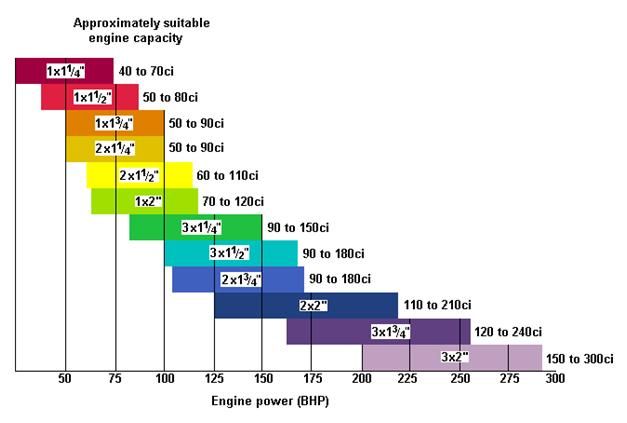 Note that the chart indicates that racing engines may require one size larger carburetor than shown, that economy engines may be suitable with one size smaller, and that supercharged engines can produce 80% more power from a given carburetor and hence the carburetor can be correspondingly smaller. Taking this into account, the chart can be redrawn as follows for supercharged applications: 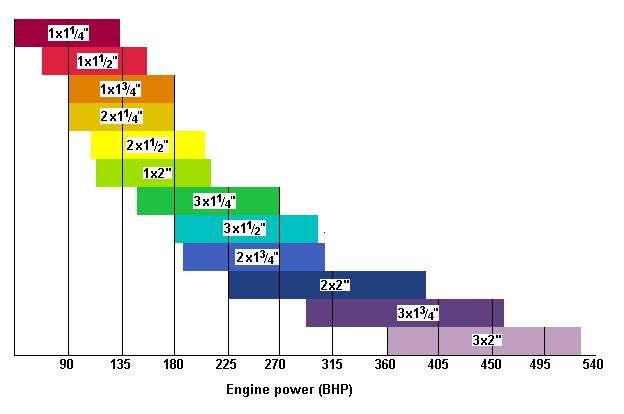 If we look at our supercharged 138ci Holden grey motor, and aim for a 50% power increase over the factory 75HP, then we are targeting around 110HP. The chart above shows that Eldred’s guidance of a single 2” SU is not too bad, with some spare capacity. So as a rough guide, two 1½” SUs or a single 2” SU are suitable for supercharged grey motors. For those not chasing grunt a single 1¾” or two 1¼” SUs may suffice. Those looking to push the grey to its limits should conside three 1¼” SUs. Cheers, Harv (deputy apprentice Norman fiddler). |
|
|
|
|
 Logged
Logged
|
|
|
|
|
FCRB26
|
 |
« Reply #67 on: October 20, 2013, 07:02:37 AM » |
0
|
|
|
|
|
|
 Logged
Logged
|
|
|
|
|
Harv
|
 |
« Reply #68 on: October 20, 2013, 07:55:16 AM » |
0
|
McCullough VS57 - a mid 1950's centrifugal good for around 5psi. Common in the States - they made 1000's of them. More info here: http://vs57.y-block.info/history.htmCheers, Harv (appreciator of early engineering  ) |
|
|
|
|
 Logged
Logged
|
|
|
|
|
NES304
|
 |
« Reply #69 on: October 20, 2013, 08:01:22 AM » |
0
|
The Code stamped into the tag can be used with the table below to identify the original vehicle:
Code Model Vehicle
AUC864F H4 Riley One-Point-Five 1498cc 4-cylinder engine 1957-1964.
AUC864R H4 Riley One-Point-Five 1498cc 4-cylinder engine 1957-1964.
AUC968 HS6 Rover 2000 1975cc 4-cylinder engine 1963-1964.
AUC976 HS2 Austin Mini 848cc 4-cylinder engine 1962-1968.
AUC979 HS2 Wolseley 1500 1485cc 4-cylinder engine 1962-1964.
AUC982 HD8 Rover 3 litre Coupe P5 2995cc 6-cylinder engine 1963-1964.
AUD1026A HD8 Rolls Royce Silver Shadow (Sweden, Japan and Australia) 6750cc 8-cylinder engine 1975.
AUD1026B HD8 Rolls Royce Silver Shadow (Sweden, Japan and Australia) 6750cc 8-cylinder engine 1975.
AUD1040A HD8 Rolls Royce Silver Shadow/Corniche 6750cc 8-cylinder engine 1975/.
AUD1040B HD8 Rolls Royce Silver Shadow/Corniche 6750cc 8-cylinder engine 1975/.
AUD104L HS2 Austin Mini Cooper Mark I and Mark II 998cc 4-cylinder engine 1964-1969, Morris Mini Cooper 998cc 4-cylinder engine 1964-1969 and Universal Power Drives Unipower 998cc4-cylinder engine.
AUD104R HS2 Austin Mini Cooper Mark I and Mark II 998cc 4-cylinder engine 1964-1969, Morris Mini Cooper 998cc 4-cylinder engine 1964-1969 and Universal Power Drives Unipower 998cc4-cylinder engine.
AUD109F HD6TH Jaguar 3.4 Mark III 3442cc 6-cylinder engine 1963-1964 and Jaguar 3.8 Mark II 3781cc 6-cylinder engine 1963-1964.
AUD109R HD6 Jaguar 3.4 Mark III 3442cc 6-cylinder engine 1963-1964 and Jaguar 3.8 Mark II 3781cc 6-cylinder engine 1963-1964.
AUD111C HD8 Jaguar Mark X 3781cc 6-cylinder engine 1963-1964.
AUD111F HD8TH Jaguar Mark X 3781cc 6-cylinder engine 1963-1964.
AUD111R HD8 Jaguar Mark X 3781cc 6-cylinder engine 1963-1964.
AUD112C HD8 Jaguar ‘E’ Type 3781cc 6-cylinder engine 1963-1964.
AUD112F HD8 Jaguar ‘E’ Type 3781cc 6-cylinder engine 1963-1964.
AUD112R HD8 Jaguar ‘E’ Type 3781cc 6-cylinder engine 1963-1964.
AUD114 HD8 Rover 3 litre P5 2995cc 6-cylinder engine 1963-1964.
AUD115 HD8 Rover 3 litre 2995cc 6-cylinder engine 1963-1964.
AUD118F HS4 Reliant Sabre Ford (Zephyr) 1700cc 4-cylinder engine 1963-1964.
AUD118R HS4 Reliant Sabre Ford (Zephyr) 1700cc 4-cylinder engine 1963-1964.
AUD120 HS2 Austin A35 van 848cc 4-cylinder engine 1965-1970.
AUD124F HD8 Austin Healey 3000 Mark III 2912cc 6-cylinder engine 1964.
AUD124R HD8 Austin Healey 3000 Mark III 2912cc 6-cylinder engine 1964.
AUD128F HD6 Alvis TD 21 6-cylinder engine1963-1964.
AUD128R HD6TH Alvis TD 21 6-cylinder engine 1963-1964.
AUD129F HD8 MG MGB Competition 1798cc 4-cylinder engine 1963-1964.
AUD129R HD8 MG MGB Competition 1798cc 4-cylinder engine 1963-1964.
AUD13 HS2 Austin A40 Mark II 1098c 4-cylinder engine 1962-1967, Austin 1100 1098cc 4-cylinder engine 1962-1967, Austin 1100 Mark II 1098cc 4-cylinder engine 1967-1971, Morris Minor 1098cc 4-cylinder engine 1962-1970 and Morris 1100 Mark II 1098cc 4-cylinder engine 1967-1968.
AUD132L HS2 Innocenti 1100 IM3 1098cc 4-cylinder engine 1963-1964.
AUD132R HS2 Innocenti 1100 IM3 1098cc 4-cylinder engine 1963-1964.
AUD135F HS4 MG MGB and GT 1798cc 4-cylinder engine 1965-1966.
AUD135R HS4 MG MGB and GT 1798cc 4-cylinder engine 1965-1966.
AUD136F HS2 Austin-Healey Sprite MK III 1098cc 4-cylinder engine 1964-1966, Austin-Healey Sprite MK IV 1275cc 4-cylinder engine 1967-1968, MG Midget Mark II 1098cc 4-cylinder engine 1964 and MG Midget Mark III 1275cc 4-cylinder engine 1967-1968.
AUD136R HS2 Austin-Healey Sprite MK III 1098cc 4-cylinder engine 1964-1966, Austin-Healey Sprite MK IV 1275cc 4-cylinder engine 1967-1968, MG Midget Mark II 1098cc 4-cylinder engine 1964 and MG Midget Mark III 1275cc 4-cylinder engine 1967-1968.
AUD139L HD8 Daimler V8 Majestic Major and Majestic 4561cc 8-cylinder engine 1964.
Please tell me you cut n pasted and didn't re type it all?  |
|
|
|
|
 Logged
Logged
|
|
|
|
|
Harv
|
 |
« Reply #70 on: October 20, 2013, 10:42:32 AM » |
0
|
Please tell me you cut n pasted and didn't re type it all? Sadly, no - I typed that lot in. There is a heap of SU info on the net, but this is the only place I know of that (now  ) has all the various SU models listed electronically. Cheers, Harv (he of the weary keyboard fingers). |
|
|
|
|
 Logged
Logged
|
|
|
|
|
Harv
|
 |
« Reply #71 on: October 21, 2013, 04:41:53 PM » |
0
|
It would be sacriledge to talk SUs, and not mention the very, very large 3” SU carbs made specifically for Eldred Norman. To put this into perspective, if your typical Mini is running a pair of HS2s (or a single HS4), and your typical Norman-blown grey motor is running a pair of HS6 or a single HS8, this monster would be a HS16. The carbs are even more rare than the superchargers themselves, and are twin-needle/jet setups. The twin needles are visible in the throat of the carburettor shown below (which I have taken from Supercharge!)... along with a 20c piece for perspective. 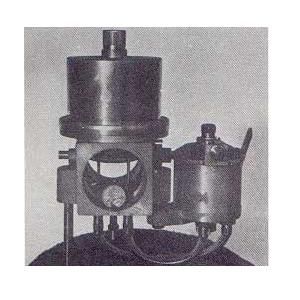 Note the size of the float bowl on the side of the carburettor... almost the size of a billy can. The two photos below right show the 3” Norman SU on a grey motor located in one of the FE/FC Holden forum members vehicles. 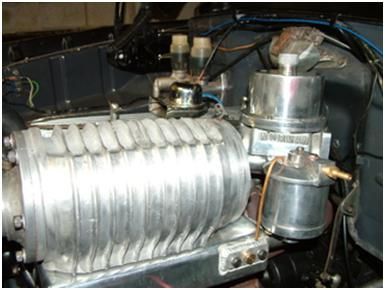 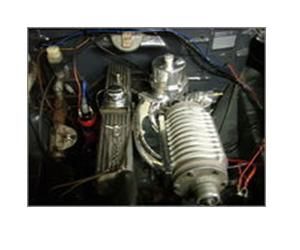 The image below shows Keith Rilstone's 2.3L 280-300bhp ex-Eldred Norman Zephyr special. The photo was taken at the Mallala Race Circuit South Australia. The car was previously known as the the Norholfordor - because it was built from Holden, Ford and Tempo Matador parts, and then the Zephyr Eclipse (from the Adelaide Ford dealer, Eclipse Motors). 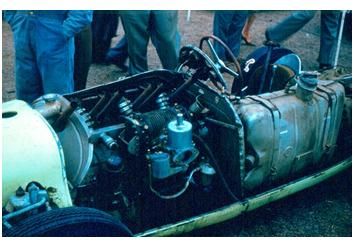 Red motor anyone? 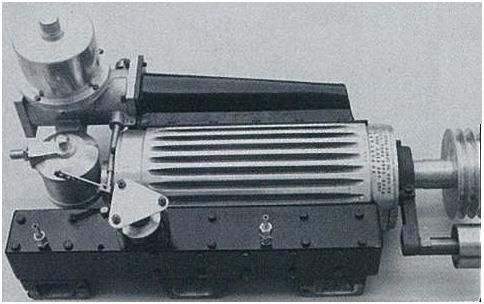 Cheers, Harv (appreciator of monster SUs) |
|
|
|
|
 Logged
Logged
|
|
|
|
|
FCRB26
|
 |
« Reply #72 on: November 13, 2013, 08:14:41 PM » |
0
|
  tempted to buy this to run on my grey but dont know enough about them as to what size or how to fit |
|
|
|
|
 Logged
Logged
|
|
|
|
|
Harv
|
 |
« Reply #73 on: November 13, 2013, 09:13:50 PM » |
0
|
Rough as guts guidance: a) its a later (Mike Norman) blower. Rare as rocking horse poo, but an order of magnitude more common that the (Eldred Norman) blowers. b) Generally better suited to a red than a grey. Will need to be underdriven (0.5-0.8:1) on a grey. c) Expensive if you are chasing grunt. Better if you are chasing period-chic. d) Needs manifolds, pop-off valve, carbs and water injection. Count on a lot of cash unless you can weld (unlike me  ). e) Very interested in casing length. Mike made a number of capcities by changing the extrusion length. Cheers, Harv |
|
|
|
|
 Logged
Logged
|
|
|
|
|
Harv
|
 |
« Reply #74 on: November 22, 2013, 03:29:03 PM » |
0
|
In this post, I will cover some of the preparations required for the casing liner. I know this is jumping around a bit from the last post on SUs, but that’s the price you pay for me doing this as a string of forum posts (if I did it as a Guide, the sequencing is more logical with less jumping around… but would take me longer to get the finished product to you). Norman superchargers have an alloy casing with a steel liner. Later Norman superchargers (and potentially also the earlier ones) had the casing liner surface hardened by Tuff-Trided. Tuff-Triding (also known as salt bath ferritic nitrocarburizing) is a steel hardening process. It works by adding extra nitrogen and carbon into the iron. Tuff-Triding improves scuffing, fatigue and corrosion properties by producing a layer of hardened material (iron nitride) of 10-20µm (0.0003-0.0006”) thick, with a surface hardness of 800-1,500HV (Vickers scale – mild steel is typically 230HV, whilst tungsten carbide is 2,500 and diamond is 10,000HV). The metal under this thin, hard layer is also changed by the process. Over time, the Tuff-Tride surface can be removed (by wear, corrosion or poor machining). To check if the Tuff-Tride treated surface is still present, copper sulphate can be used. If the hard iron nitride surface is still present, the copper sulphate won’t react. If the Tuff-Triding has been removed however the copper sulphate can get at the iron and will react (for the science geeks, the iron will reduce the copper, leading to the copper plating out: Fe + CuSO4 → FeSO4 + Cu). To do the testing: a) I bought some copper sulphate. This is available as “bluestone” from nurseries – it is a pretty common algaecide used to control weeds in paths and algae in water. b) I sat the supercharger barrel horizontal, and cleaned the test area with some thinners - there must be no traces of oil on the surface to be tested. c) I made up a 5 - 10% solution of copper sulphate dissolved in distilled water. This is the blue liquid you can see in the photos sitting in an upturned grey spray paint tin lid. d) I applied a dab of the solution to the surface being inspected, leaving in place for 30 - 40 seconds. f) If there is discoloration (i.e. the solution changes from a light blue colour to transparent and the steel surface takes on a copper/rust color) after this time, the Tuff-Tride treatment has been removed. If the solution stays a blue colour, the Tuff-triding is still present. g) I washed down the steel surface immediately with plenty of water, as copper sulphate is corrosive. I then re-oiled the surface to protect against rust. When I did the testing, I found that the Tuff-Triding was still present on my small Norman, my large Norman and Gary’s large Norman. However, the Tuff-Triding had been removed from the surface of Gary’s Type 65 Norman. You can see in the photo where the copper from the copper sulphate solution has plated out onto the liner surface (don’t panic, this copper does not stick to the casing, and wipes off easily). 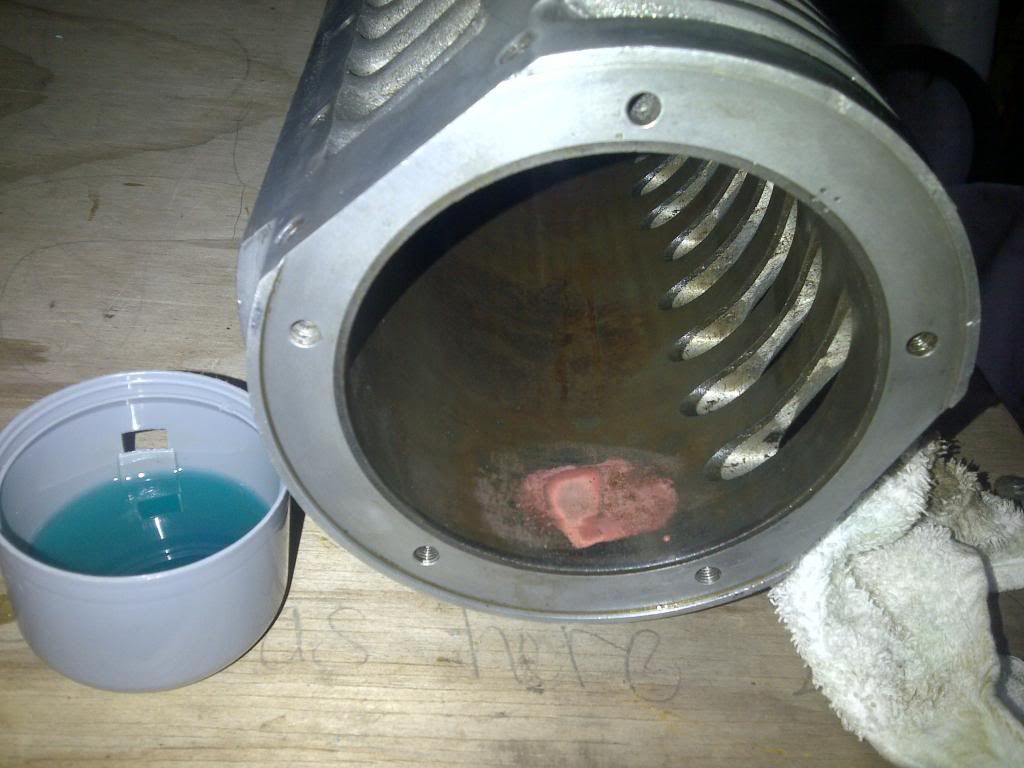 |
|
|
|
|
 Logged
Logged
|
|
|
|
|
Harv
|
 |
« Reply #75 on: November 22, 2013, 03:29:45 PM » |
0
|
Later machining of the Type 65 shows that although the Tuff-Triding had been removed from the surface, it still had a thin hard layer underneath (this is the changes in the parent metal that also come with Tuff-Triding). Note that so far I haven’t tested my water cooled Norman or my clutched Norman as I ran out of time – I wanted the casings cleaned and checked before testing and machining. The reason for the above testing is to work out whether or not to hone the casings. Honing is required to clean up any small surface scratches in the casing, and more importantly to leave behind a cross-hatch pattern. The cross-hatching provides a surface that will retain an oil film, which we need to lubricate the vanes as they whizz around (retaining an oil film is exactly the same reason that engine cylinders are honed). For sliding vane superchargers that are not case-hardened (for example Judson superchargers) honing is undertaken at all overhauls. However, there is a bit of a trade-off here if the surface is Tuff-Trided, like the Normans. Honing will generally remove 0.003-0.005” of material (… or more if heavy handed). Bearing in mind that the original Tuff-Triding is probably only 0.0003-0.0006” thick (maybe 0.0015” if it is old, old Tuff-Triding), there is a pretty good chance that honing will remove the case hardening. This will reduce the life of the supercharger barrel. It is of course possible to press out the barrel liner, have it case hardened again and refitted… though this is a pretty substantive task with good risk of damage and expensive. It really becomes a balance between good oiling (and hence longer vane life) against reduced casing life. For what it’s worth (and after having had a good long discussion with a very experienced machine shop and a Tuff-Triding shop), I take the following view: a) If the case hardening is not present, hone the casing. b) If the case hardening is present, but the casing shows significant corrosion or heavy scratches, hone the casing. c) If the case hardening is present, but the casing is otherwise OK, do not hone the liner. Note that an alternative to honing (say to remove very limited corrosion) is to polish internally by either lapping with emery cloth (grade 360 or finer), or blasting with glass beads (size 40-70μm in diameter, with pressure less than 4 bar). Polishing in this manner is supported by the Tuff-Tride process owner ( Reference: TUFFTRIDE®-/QPQ®-PROCESS Technical Information, Dr. Joachim Boßlet / Michael Kreutz, Durferrit GmbH ( http://www.durferrit.com).), but can however partly reduce the corrosion resistance of the liner. Using the above logic, I took the decision to hone my small Norman (case hardening present, but casing showing significant corrosion) and Gary’s Type 65 Norman (case hardening worn off), but did not hone Gary’s large Norman or my large Norman (case hardening present and casings generally in good condition). The honing was completed by Duncan Foster Engineering, one of the few places around that have hones for the large diameter supercharger barrels (many engine reconditioners can only hone smaller engine-cylinder type diameters). The photos attached show the nice cross-hatching obtained. 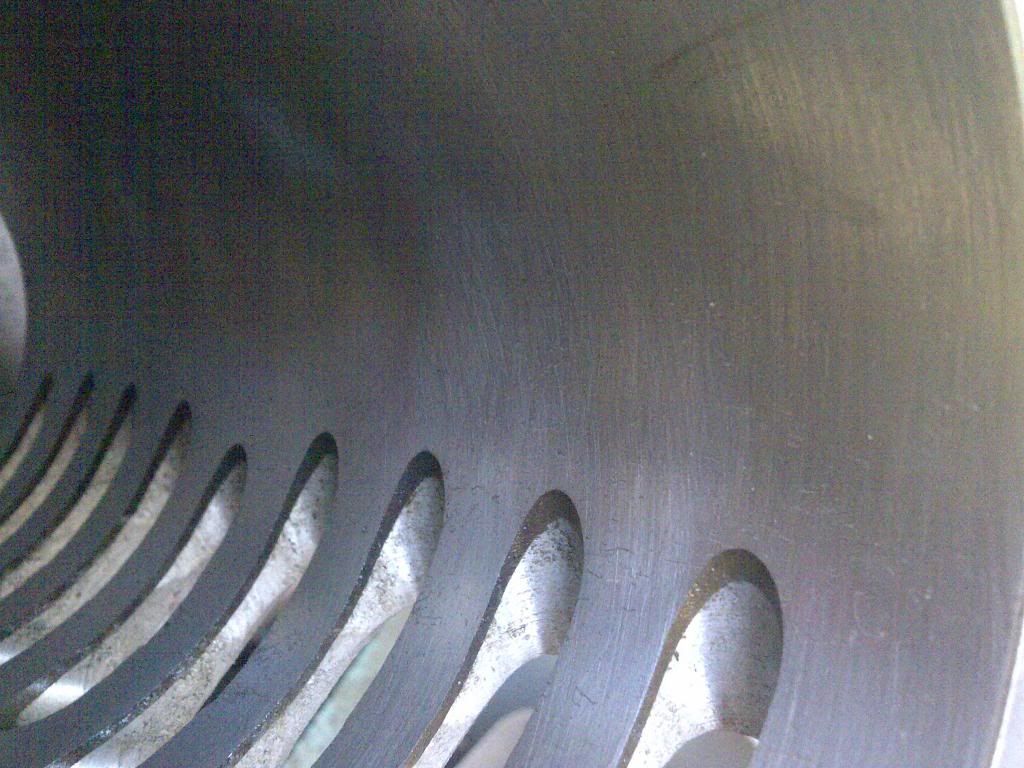 Cheers, Harv (deputy apprentice Norman supercharger fiddler) |
|
|
|
|
 Logged
Logged
|
|
|
|
|
Harv
|
 |
« Reply #76 on: November 26, 2013, 11:12:56 AM » |
0
|
For this post, we will take a look at the rotors that are used in Norman superchargers. Now that we are starting to look at internals, the sketch below may help to better visualize the way that the Normans are put together:  The shaft of a sliding vane supercharger supports the rotor, which may be made from steel or from aluminum alloy. Whilst Norman superchargers have solid rotors, some supercharger rotors are made from hollow extruded sections in order to minimize weight. The rotor may be mounted centrally within the casing, or may be mounted eccentrically (Norman superchargers are eccentric, whilst the vanes in many air tools are mounted centrally). The rotor contains a number of slots (two, four, six or more), which may be radial or tangential (Norman superchargers are tangential), whilst air tools for example are often radial).  The slots carry the rotor vanes, which are free to slide in and out of the slots. Centripetal force causes the vanes to be held outwards against the walls of the casing, forming a seal. A significant change is noticeable between Eldred’s earlier rotors and the later ones produced by Mike Norman. The earlier rotors are steel, drilled through with the steel drive shaft welded in. These rotors are four-vane units as per the left-hand image below. The later model rotors are machined from a light alloy bar before being fitted with a steel driveshaft. These rotors are three-vane units, as per the right-hand image below. 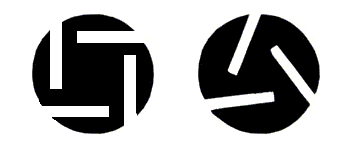 Additionally, the later model rotors have Tuff-Trided sheet steel inserts riveted into the vane slots (as per the red lines on the image below) to decrease rotor slot wear. The inserts can be seen riveted into the vane slots in the left hand corner of the photo below. 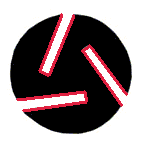 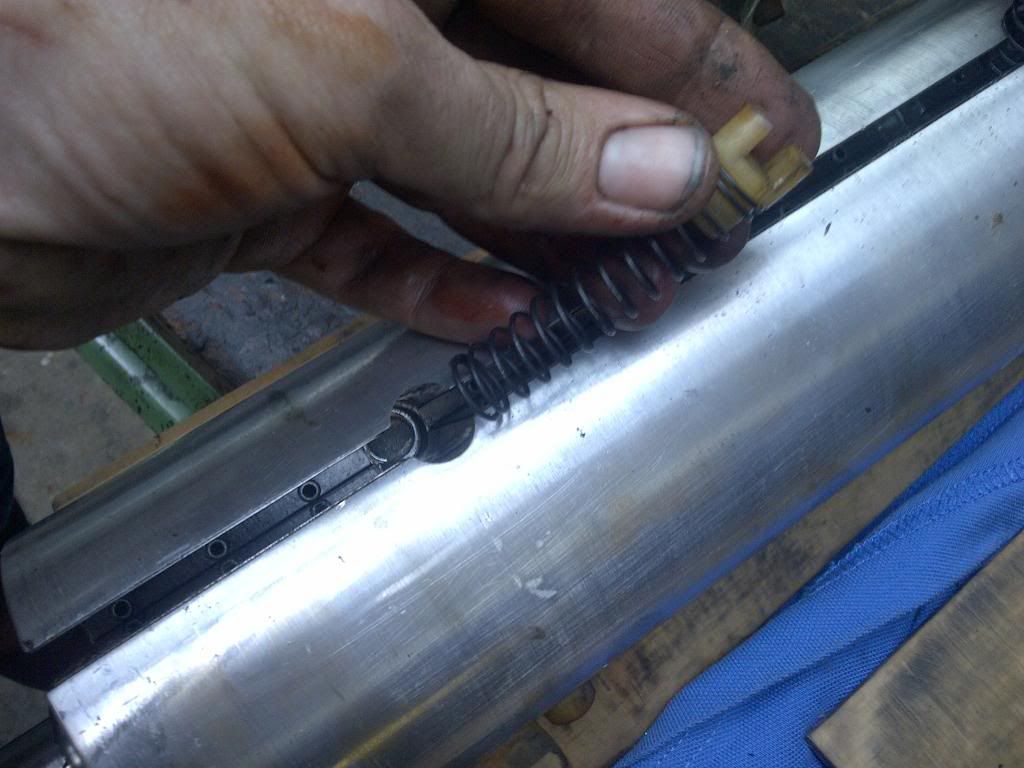 A typical rotor (this is Gary’s Type 65) is shown below:  At some stage I'll sketch up the rest of the rotors and post them here (time is not on my side at the moment :oops: ). The rotors have a number of common features: • Lands at either end of the shaft to support both the drive-end and non-drive end bearings, • A land at the drive end to support the drive-end seal, • A keyway milled into the drive-end of the shaft to provide axial locking of the drive pulley, and • A threaded section at the end of the shaft to mount the pulley retaining nut. Note that Norman superchargers do not have thrust bearings. Any thrust loading is transferred through to the drive-end and non-drive end bearings. To minimize thrust (and maintain adequate clearance) care needs to be taken in the selection of the gaskets between the main casing and end plates. Whilst no guidance exists for the Normans, typical Judson supercharger practice is to select the gasket thickness such that 0.010” float exists between the rotor and end case at each end. 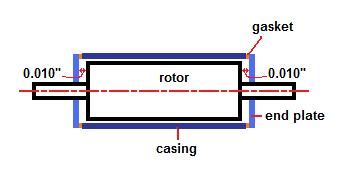 |
|
|
|
|
 Logged
Logged
|
|
|
|
|
Harv
|
 |
« Reply #77 on: November 26, 2013, 11:13:36 AM » |
0
|
As the rotor spins, the vanes are forced against the casing wall by centripetal force. The eccentric rotor position means that the vanes slide in and out as the rotor spins. When the vanes are travelling into the rotor, they develop some inertia, and want to keep travelling inwards. As the rotor keeps spinning to the point that the vanes should come out again, the vanes will have a tendency to stay in the rotor slot and hence lift off the casing wall slightly. This tends to happen after the discharge port is passed (and before the inlet port is reached) and hence is probably not much of an efficiency loss. However, the lift-off adds to the supercharger nose, and the repeated banging of the vanes is probably not good for their longevity. To combat the vane lift-off, the latter alloy rotors are fitted with vane springs. The springs are fitted into holes (pockets) drilled into each rotor slot. A plastic bush is fitted between the compression spring and the vane prior to the vane being inserted into the rotor. The springs provide an outwards force on the vane, similar to the centripetal force that normally pushed the vanes out. The spring operation will be periodic – typically the vehicle will run for 30-60 minutes at a time, with rest periods in between when the car is shut down. During rest periods the springs will be at ambient temperature, though during service will increase. The springs will typically cycle at around crankshaft speed – say a maximum of 4500 cycles per minute, though probably on average 2500 cycles per minute. The springs will operate in an environment of a gasoline/air/oil vapour, with some humidity. Whilst no free water is likely, water content may approach saturation. It is a fair assumption that the springs will only be checked when the supercharger is overhauled – if we used Eldred’s guidance of servicing every 20,000 miles, then the springs are likely to complete 65 million cycles before seeing daylight again. All of this adds up to a very harsh operating environment for a spring to operate in – bear in mind that typical commercially available springs (other than specialties like valve springs) are normally only factory fatigue tested to 10,000 cycles. Most commercial springs are also good for only around ¾” of deflection, whilst the Norman springs deflect around 1½”. The original springs have a reputation for failing in service, and are often removed by enthusiasts to prevent failure. If the springs do fail in service, most (if not all) the shards of spring are likely to be held in place by the plastic bushes, largely preventing them from entering the engine. However, there is a good chance of the hardened steel spring shards chewing out the soft alloy rotor pocket. The image above shows an original spring and bush, together with one that had failed in service. 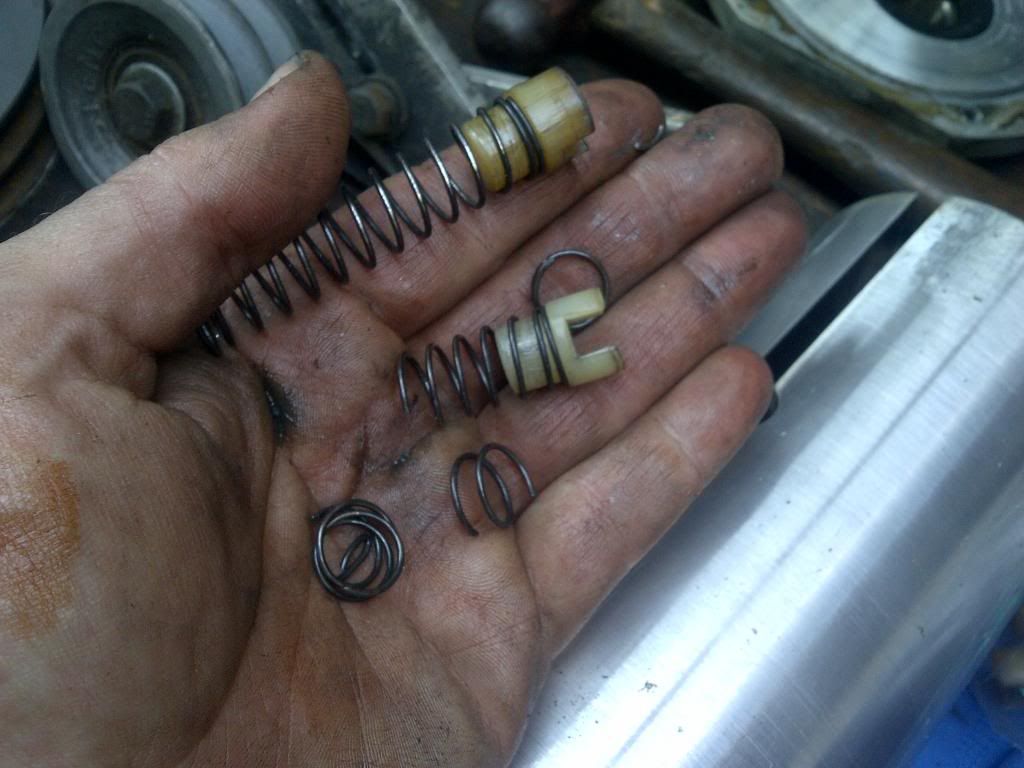 The original springs have dimensions as shown in the image below, and a stiffness of approximately 3.7lb/inch.  For those seeking replacement springs, Century Spring Corporation part number 12063 are very similar… though resist the temptation to use them, as discussion with Century show that the fatigue life is not likely to be suitable due to the spring steel material used (the springs are also a trifle heavy at 5.1lb/inch). Custom springs are likely to be required for long-term use. A suitable supplier for the springs is Boynes Springs (6 Sarich Court Osborne Park, Western Australia 6017 Australia, Telephone: (08) 94465666, Facsimile: (08) 92441465, Email: info@boynessprings.com.au, Internet: http://www.boynessprings.com.au), who can make the required springs. If anyone wants some springs for their Norman, give me a yell (I had a few spare ones made up :mrgreen: ). |
|
|
|
|
 Logged
Logged
|
|
|
|
|
Harv
|
 |
« Reply #78 on: November 26, 2013, 11:14:15 AM » |
0
|
The bushes noted above have the following dimensions: 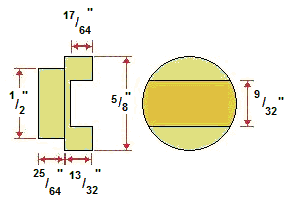 Note that the bushes could be readily made from either nylon or PTFE (Teflon). Care needs to be taken when using nylon, as some grades of nylon (for example Nylon 6.11) have melting temperatures as low as 190ºC. Whilst the supercharger will not operate that hot (without pinging its head off), the localized friction of the bushes running in their pockets will certainly increase temperature. Because of this, PTFE (with a melting temperature of 327ºC) is a better choice. As a side note, I have a 1' length of teflon bar at home that I need to machine down into the above bushes (some for me and some spares). If there are any machinists out there who would undertake this for me, I'd love to hear from you (my lathe skills are pretty poor :oops: ). The vanes used in Norman superchargers are made from Bakelite, also known as polyoxybenzylmethylenglycolanhydride. Bakelite is an early plastic, and is thermosetting (i.e. when you heat it up, it will char rather than melting). Bakelite saw quite some use in the automotive industry, for example in the manufacture of rotor buttons and distributor caps for early Holdens. The Bakelite used in Norman supercharger rotors is sometimes referred to as phenolic sheet or canvas Bakelite. This is made by applying heat and pressure to layers of cotton fabric impregnated with Bakelite resin to make a laminate. Bakelite in this form has good mechanical properties (as per the table below), is strong, rigid, shows negligible creep or cold flow under load whilst still being light (about 20-25% the weight of steel).  Canvas Bakelite is suitable for a continuous operating temperature of around 120ºC (130ºC peak). Dimensions for some of the different Norman supercharger vanes are given below: 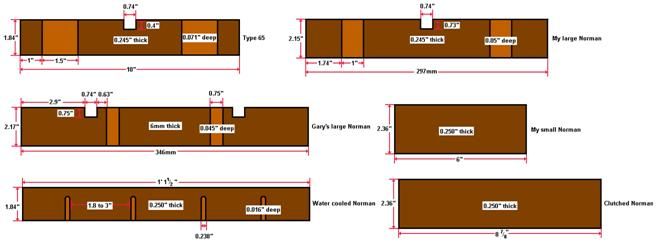 In the above diagrams, the darker sections represent the main portion of the vanes, whilst the lighter portions represent grooves that are milled into the trailing edge of the vanes. Note that some of the grooves are milled all the way across the face of the vane, whilst others are milled only partially across the face. The grooves are likely to be used to assist the vanes in being able to move in and out of the rotor. The vanes should be a “flop” fit, though may experience some changes in dimensions due to moisture, fuel properties or dirt. If the vanes become a tight fit, the oily environment they operate in may allow them to form a seal with the rotor. In this case, the vanes will draw a vacuum at the vane root as they try to slide out, or will build pressure at the vane root as they slide back in. The slots allow the vane root to equalize pressure, allowing the vanes to slide freely. The slots also allow some flow of air/fuel/oil around the vane, helping lubrication. 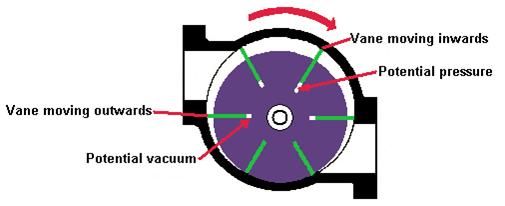 Note that some vanes also have one or two notches cut into them. The notches correspond to the vane springs, giving the plastic bushes a location to bear on the vanes. Interestingly, the Type 65 rotor in Gary’s Norman had a notch despite the rotors not having pockets for springs… perhaps an over-enthusiastic vane replacement in the past. A suitable supplier for the vanes is Bearing Thermal Resources (5 Kerr Court Rowville, Victoria 3178 Australia, Telephone: (03) 97642009, Facsimile: (03) 97641009, Email: sales@btresources.com.au, Internet: http://www.btresources.com.au), who can make the required vanes. Cheers, Harv (deputy apprentice Norman supercharger fiddler). |
|
|
|
|
 Logged
Logged
|
|
|
|
|
Harv
|
 |
« Reply #79 on: November 28, 2013, 12:07:07 PM » |
0
|
For this post we will take a look at the bearings and seals used in the Normans. Norman superchargers typically have two bearings. The drive-end of the machine is fitted with a single row ball bearing, whilst the non-drive end is fitted with a roller bearing. Dimensions of the bearings are given in the table below:  With respect to bearing lubrication, three different types of bearing arrangement are evident. In the first configuration, there is a very small gap between the casing and the rotor. This can be seen in the image below. The small gap will largely prevent the air/fuel/oil mixture (passing through the supercharger) from passing over the bearing. This means that the bearing cannot be effectively lubricated by the oil. If the bearing is of the sealed type, then no lubrication issue exists as the factory grease will provide lubrication. However, if the bearing is an open type then lubrication will be very poor, and will rely heavily on the grease packing installed during overhaul. 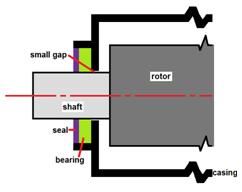 In the second type of configuration, the casing is more open, with a large gap between the casing and rotor. This can be seen in the image below. In this case the air/fuel mixture will have more contact with the bearing, and may provide some lubrication. Note however that the bearing is not oil immersed, and there is no real flow across the bearing face as one end of the bearing is blanked by the seal. The lubrication of the bearing will be very limited, and again grease packing during overhaul is recommended. 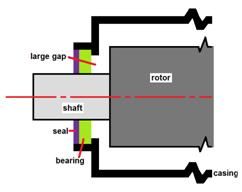 In the third configuration, the seal is observed to be installed inboard of the bearing, as per the image below. In this case the air/fuel/oil mixture provides no lubrication to the bearing. However, I have only seen this undertaken with sealed bearings, were lubrication is not required. 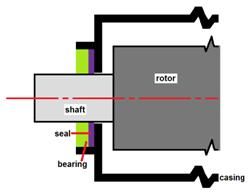 In choosing a suitable grease, care must be taken to choose an appropriate grade. For overhauling Norman superchargers I would recommend a grease such as Shell Gadus S3 T100. This grease: a) is suitable for roller and ball bearings (pretty damn important given that is what it is going onto… some greases used for king pin and chassis greasing will not be suitable), b) is good for 160ºC (a high temperature range is important particularly if no water injection is used), c) can handle higher bearing speeds, d) is water tolerant (important if we are using water injection upstream of the supercharger), and e) has a long service life (important as Norman superchargers are generally not fitted with grease nipples). |
|
|
|
|
 Logged
Logged
|
|
|
|
|



